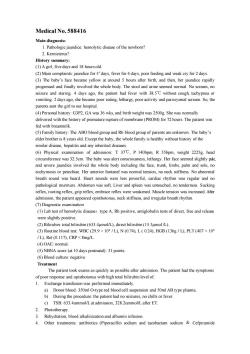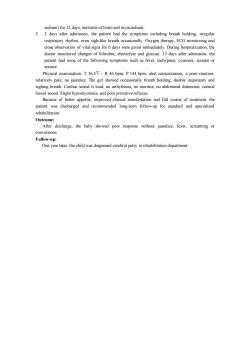《儿科学》课程作业习题(典型病例)01 ABO incompatibility of neonates

Medical No.588416Main diagnosis:1Pathologicjaundice: hemolyi disease ofthe newborn?2. Kernicterus?History summary:(fivedays and 8ursod(2) Mainor5+days,fevcryfor2daorau(3) The baby's face became yellow at around 5 hours after birth, and then, her jaundice rapidlyprogressed and finally involved the whole body. The stool and urine seemed normal. No scream, noseizure and staring. 4 days ago, the patient had fever with 38.5C without cough tachypnea orvomiting. 2 days aggo, she became poor eating, lethargy, poor activity and paroxysmal scream. So, theparents sent the girl to ourhospitary: G3P2,GA was 36 wks, and birth weight was 2500g. She was normal(4) PersCdelivered with thehistoryofprematureruptureof membrane(PROM)for72hours.Thepatient wafed with breastmilk.(5) Family history: The ABO blood group and Rh blood group of parents are unknown. The baby'selder brother is8 years old.Except the baby, the wholefamily is healthy without history oftheinheriteddise(6) Physical examination of admission: T 37C, P 140bpm, R 55bpm, weight 2225g, headcircumferencewas325cmhebaby wasalertonsciousness,lethargyHerfaceseemedslightlypaeand severe jaundice involved the whole body including the face, trunk, limbs, palm and sole, noecchymospetechiae.Heranteriorfontanel wasnormal tension,noneck stiffness.NoabnormalHeart sounds were less powerful, cardiac rhythmoreathneardregularandnopathological murmurs Abdomen was sof, Liver and spleen was untouched, no tenderness. Suckingreflex, rooting reflex, grip reflex, embrace reflex were weakened. Muscle tension was increased. Afteradmission,thepatientredopisthotonus.stiffness.alirregular breath rhythm(7)Diagnosticexaminatio(I) Labtest of hemolytic disease:type A, Rh positive, antiglobulin tests of direct, free andreleasliohtivpe(2) Bilirubin total bilirubin (633.4umol/L), direct bilirubin(15.3μmol /L).(3) Routine blood test: WBC (29.9 × 109 / L), N (0.74), L( 0.24), HGB (136g / L), PLT(407 × 109/ L), Ret (0.117), CRP<8mg/I(4)OAE:norm(5) NBNA score (at 10 days postnatal): 31 points.(6) Blood culture: negative.TreatmentThepatient took exams asquicklyas possibleafteradmission.Thepatienhad thesymptomofpoorrespoopisthotonus with hightotal bilirubin levelof.ExchangeerformedimmediatelDonor blood: 350ml O-type red blood cell suspensioand 50mlABtypeplasmaDuringthe procedure the patient had no seizures, no chills orfever.TSB: 633.4ummol/L at admission, 328.2ummol/L after ET.PhototherapyRehydration, blood alkalinization and albumin infusionOther treatments: antibiotics (Piperacillin sodium and tazobactam sodium & Cefpiramide
Medical No. 588416 Main diagnosis: 1. Pathologic jaundice: hemolytic disease of the newborn? 2. Kernicterus? History summary: (1) A girl, five days and 18 hours old. (2) Main complaints: jaundice for 5+ days, fever for 4 days, poor feeding and weak cry for 2 days. (3) The baby’s face became yellow at around 5 hours after birth, and then, her jaundice rapidly progressed and finally involved the whole body. The stool and urine seemed normal. No scream, no seizure and staring. 4 days ago, the patient had fever with 38.5℃ without cough, tachypnea or vomiting. 2 days ago, she became poor eating, lethargy, poor activity and paroxysmal scream. So, the parents sent the girl to our hospital. (4) Personal history: G3P2, GA was 36 wks, and birth weight was 2500g. She was normally delivered with the history of premature rupture of membrane (PROM) for 72 hours. The patient was fed with breastmilk. (5) Family history: The ABO blood group and Rh blood group of parents are unknown. The baby’s elder brother is 8 years old. Except the baby, the whole family is healthy without history of the similar disease, hepatitis and any inherited diseases. (6) Physical examination of admission: T 37℃, P 140bpm, R 55bpm, weight 2225g, head circumference was 32.5cm. The baby was alert consciousness, lethargy. Her face seemed slightly pale, and severe jaundice involved the whole body including the face, trunk, limbs, palm and sole, no ecchymosis or petechiae. Her anterior fontanel was normal tension, no neck stiffness. No abnormal breath sound was heard. Heart sounds were less powerful, cardiac rhythm was regular and no pathological murmurs. Abdomen was soft, Liver and spleen was untouched, no tenderness. Sucking reflex, rooting reflex, grip reflex, embrace reflex were weakened. Muscle tension was increased. After admission, the patient appeared opisthotonus, neck stiffness, and irregular breath rhythm. (7) Diagnostic examination (1) Lab test of hemolytic disease:type A, Rh positive, antiglobulin tests of direct, free and release were slightly positive. (2) Bilirubin: total bilirubin (633.4μmol/L), direct bilirubin (15.3μmol /L). (3) Routine blood test: WBC (29.9 × 109 / L), N (0.74), L ( 0.24), HGB (136g / L), PLT (407 × 109 / L), Ret (0.117), CRP < 8mg/L. (4) OAE: normal. (5) NBNA score (at 10 days postnatal): 31 points. (6) Blood culture: negative. Treatment The patient took exams as quickly as possible after admission. The patient had the symptoms of poor response and opisthotonus with high total bilirubin level of. 1. Exchange transfusion was performed immediately. a) Donor blood: 350ml O-type red blood cell suspension and 50ml AB type plasma. b) During the procedure: the patient had no seizures, no chills or fever. c) TSB: 633.4ummol/L at admission, 328.2ummol/L after ET. 2. Phototherapy. 3. Rehydration, blood alkalinization and albumin infusion. 4. Other treatments: antibiotics (Piperacillin sodium and tazobactam sodium & Cefpiramide

odium) for 12 davs. nutrients of brain and mvocardiun2 days afer admission, the patient had the symptoms including breath holding, iregularrespiratory rhythm, even sigh-like breath occasionally.Oxygen therapy,ECG monitoring andclose observation of vital signs for 6 days were given immediately.During hospitalization, thedoctor monitored changes of bilirubin, electrolyte and glucose.13 days after admission, thepatient had none of the follo/mptoms suchasfever,tachypnea,cyalseizu: T 36.5C, R 46 bpm, P144 bpm, alert crelatively pale, no jaundiceThe girl showed occasionally breath holding,doubleinspiratory andsighingbreathCardiac sound isloud,noahythmia,nomurmur,noabdominaldistention,normabowel sound.Slighthypomyotonia,and poorprimitivereflexesseofbetterappetite, improved clinical manifestation andfullcourseoftreatment,theacpatientwas discharged and recommended long-tem follow-up for standard and specializedrehabilitation.Outcome:After discharge,the baby showed poor response without jaundice, fever, screamingoconvulsionsFollow-upOne year later,the childwasdiagnosed cerebral palsy inrehabilitationdepartmen
sodium) for 12 days, nutrients of brain and myocardium. 5. 2 days after admission, the patient had the symptoms including breath holding, irregular respiratory rhythm, even sigh-like breath occasionally. Oxygen therapy, ECG monitoring and close observation of vital signs for 6 days were given immediately. During hospitalization, the doctor monitored changes of bilirubin, electrolyte and glucose. 13 days after admission, the patient had none of the following symptoms such as fever, tachypnea, cyanosis, scream or seizure. Physical examination: T 36.5℃,R 46 bpm, P 144 bpm, alert consciousness, a poor reaction, relatively pale, no jaundice. The girl showed occasionally breath holding, double inspiratory and sighing breath. Cardiac sound is loud, no arrhythmia, no murmur, no abdominal distention, normal bowel sound. Slight hypomyotonia, and poor primitive reflexes. Because of better appetite, improved clinical manifestation and full course of treatment, the patient was discharged and recommended long-term follow-up for standard and specialized rehabilitation. Outcome: After discharge, the baby showed poor response without jaundice, fever, screaming or convulsions. Follow-up: One year later, the child was diagnosed cerebral palsy in rehabilitation department
按次数下载不扣除下载券;
注册用户24小时内重复下载只扣除一次;
顺序:VIP每日次数-->可用次数-->下载券;
- 《儿科学》课程作业习题(典型病例)03 congenital heart disease-TOF.doc
- 《儿科学》课程作业习题(典型病例)07 congenital hypothyroidism.doc
- 《儿科学》课程作业习题(典型病例)05 purulent meningitis.doc
- 《儿科学》课程作业习题(典型病例)04 iron deficiency anemia.doc
- 《儿科学》课程作业习题(典型病例)03 congenital heart disease-VSD.doc
- 《儿科学》课程作业习题(典型病例)08 diarrhea.doc
- 《儿科学》课程作业习题(典型病例)06 anute nepheritis-1.doc
- 《儿科学》课程作业习题(典型病例)06 nephrotic syndrome-2.doc
- 《儿科学》课程作业习题(复习题)01 questions of children healthcare.doc
- 《儿科学》课程作业习题(复习题)02 questions of neonatal diseases.doc
- 《儿科学》课程作业习题(复习题)05 questions of blood disorders.doc
- 《儿科学》课程作业习题(复习题)04 questions of circulatory system.doc
- 《儿科学》课程作业习题(复习题)03 questions of respiratory diseases.doc
- 《儿科学》课程作业习题(复习题)06 questions of nervous system.doc
- 《儿科学》课程作业习题(复习题)10 questions of infectious diseases.doc
- 《儿科学》课程作业习题(复习题)09 questions of endocrine disorders.doc
- 《儿科学》课程作业习题(复习题)07 questions of urinological system.doc
- 《儿科学》课程作业习题(复习题)08 questions of immune system.doc
- 《儿科学》课程教学资源(授课教案)12 Acute Glomerulonephritis,Nephrotic Syndrome.doc
- 《儿科学》课程教学资源(授课教案)11 Acute Convulsion in Children.doc
- 《儿科学》课程作业习题(典型病例)02 pneumonia.doc
- 《儿科学》课程作业习题(试卷和答案)双语试卷C卷(试题).doc
- 《儿科学》课程作业习题(试卷和答案)双语试卷B卷(试题).doc
- 《儿科学》课程作业习题(试卷和答案)双语试卷B卷(答案).doc
- 《儿科学》课程作业习题(试卷和答案)双语试卷C卷(答案).doc
- 《儿科学》课程作业习题(试卷和答案)双语试卷A卷(试题).doc
- 《儿科学》课程作业习题(试卷和答案)双语试卷A卷(答案).doc
- 《儿科学》课程教学课件(PPT讲稿)07 新生儿缺氧缺血性脑病 Hypoxic-ischemic Encephalopathy(HIE).pptx
- 《儿科学》课程教学课件(PPT讲稿)06 新生儿败血症 Neonatal Septicemia.pptx
- 《儿科学》课程教学课件(PPT讲稿)21 Chronic Gastritis in Children.pptx
- 《儿科学》课程教学课件(PPT讲稿)20 Toxic Bacillary Dysentery.pptx
- 《儿科学》课程教学课件(PPT讲稿)27 Inflammation Causes Cholesterol Redistribution by Diverting Cholesterol from Circulation to Tissue Tompartments.pptx
- 《儿科学》课程教学课件(PPT讲稿)26 Rotavirus Infection in Children.pptx
- 《儿科学》课程教学课件(PPT讲稿)25 Scarlet Fever.pptx
- 《儿科学》课程教学课件(PPT讲稿)24 Mumps(Epidemic parotitis).pptx
- 《儿科学》课程教学课件(PPT讲稿)23 Infantile Hepatitis Syndrome.pptx
- 《儿科学》课程教学课件(PPT讲稿)22 Infantale Diarrhea and Fluid Therapy.pptx
- 《儿科学》课程教学课件(PPT讲稿)19 Pediatric Tuberculosis.pptx
- 《儿科学》课程教学课件(PPT讲稿)18 Varicella.pptx
- 《儿科学》课程教学课件(PPT讲稿)17 Measles.pptx
